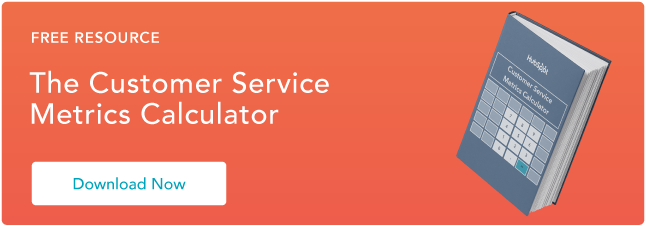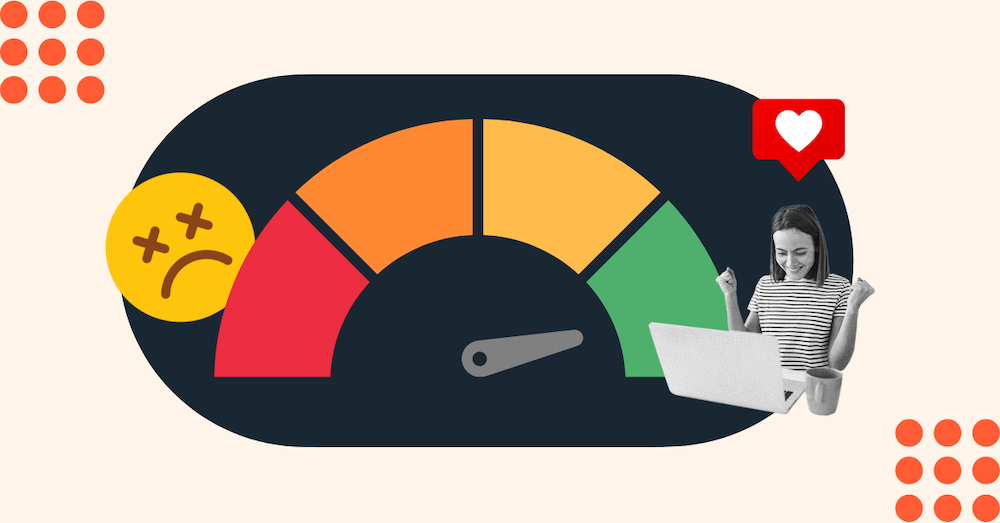Measuring customer satisfaction doesn‘t have to be complicated or expensive. In fact, it’s fairly simple to incorporate customer feedback into your current customer success strategy.
In this post, we'll cover the steps for:
- measuring customer satisfaction
- tools to measure customer satisfaction
- ways to achieve customer satisfaction
How to Measure Customer Satisfaction
- Define your goals.
- Outline a plan.
- Choose a type of customer satisfaction survey.
- Customize your survey's layout and questions.
- Determine your survey's trigger.
- Select your survey medium.
- Analyze your survey data.
- Make adjustments and repeat.
1. Define your goals.
When embarking on any sort of campaign, it's helpful to take a step back and ask, “Why are we doing this?”
In business, one must weigh the value of information — the customer satisfaction data — against the cost of collecting it — the survey process. To be honest, if you won‘t change anything after collecting your customer satisfaction data, you’re better off not collecting it at all. It's going to take time and effort, so you need to put it to use.
Depending on your business or organizational capabilities, there‘s a lot you can do with this information. It’s important to have a goal in mind so you can get the most out of your customer data. Every business faces disappointed or upset customers, but not every company has a solution.
With that in mind, the specific solution isn't necessarily the important part here. The important part is stepping back and saying, “If we see that a segment of our customers is unsatisfied, what will we do about it?”
2. Outline your plan.
Once your goals are defined, you need an actionable plan to achieve them. Before collecting customer data, your team should outline the actions you'll take after feedback is gathered and analyzed. Some examples you can execute are:
- Improve key UX bottlenecks that contribute to poor customer experience.
- Expedite customer support interactions with the most frustrated customers.
- Operationalize proactive support like a knowledge base and customer education.
- Test different live chat scripts and support strategies.
You can also plan actions based on your segment of highly satisfied customers. Methodologies like NPS® segment your customers into promoters, passives, and detractors for a few reasons. First, NPS provides you with an aggregate satisfaction score, thus providing a health check and a longitudinal metric to track and improve over time.
Second, it gives you the possibility of segmenting customers based on attitudinal metrics like satisfaction. You can offer your promoters special perks or encourage them to spread the word about your business; they're the most probable people to act as your “external sales force” — in other words, your willing and excited customer advocates.
3. Choose a type of customer satisfaction survey.
Once you‘ve sat down and discussed your plans with key stakeholders, you need to design your survey. The first step you should take is determining the type of metrics you’ll use to measure customer satisfaction.
You can choose among a few different options for customer satisfaction surveys. There's no unanimous agreement on which one is best. A few popular methods are:
Customer Satisfaction Score (CSAT)
Customer Satisfaction Rating, or Customer Satisfaction Score (CSAT) measures on average, how satisfied or unsatisfied customers are with your product, services, or customer success program. Usually asked on a scale of 1-3, 1-5, or 1-7, your customer satisfaction score can be calculated by adding up the sum of all scores and dividing the sum by the number of respondents.
Customer Satisfaction Score (CSAT) is the most commonly used measurement for customer satisfaction. You ask your customers to rate their satisfaction on a linear scale. Your survey scale can be 1 – 3, 1 – 5, 1 – 7, or 1 – 10, and there's no universal agreement on which scale is best to use.
CSAT is a metric used to immediately evaluate a customer‘s specific experience. Here’s how Vipin Thomas, Global Lead of Customer Success at Freshdesk, put it:
"CSAT is a transactional metric that‘s based on what’s happening now to a user‘s satisfaction with a product or service. We try to get a CSAT score within 15 minutes of an interaction. It’s super helpful to improvise on the resolution, mode of delivery, channel, etc. It's ONE of the important metrics to evaluate the performance of the support desk. In fact, we publish ours publicly as well."
Customer Effort Score (CES)
Customer Effort Score (CES) is very similar, but instead of asking how satisfied the customer was, you ask them to gauge the ease of their experience.
You‘re still measuring satisfaction, but this way you’re gauging user effort — the assumption being that the easier a task is, the better the experience will be. As it turns out, making an experience a low-effort one is one of the greatest ways to reduce frustration and disloyalty.
Net Promoter Score® (NPS)
NPS asks the question, “How likely is it that you would recommend this company to a friend or colleague?”
You calculate your Net Promoter Score by subtracting the percentage of detractors from the percentage of promoters. This measures customer satisfaction but also customer loyalty. In doing so, you can come up with an aggregate score, but you can also segment your responses into three categories: detractors, passives, and promoters.
NPS is often used as a more general indicator of customer loyalty and brand devotion. Here's how Thomas explains it:
“NPS is consumed by various different teams to drive retention, sales, product improvements & advocacy. Some important things to consider would be the channel it's delivered on — email, in-product, phone — the frequency of delivery, and the target audience within the customer base”.
Customer Satisfaction Index (CSI)
Another way to categorize customer satisfaction is with the Customer Satisfaction Index or CSI. It measures how satisfied your customers are with your products or services on an individual basis.
For example, CSI can measure things like:
- Customer service
- Product satisfaction
- Pricing
- Ease of use
- Perceived value
Then, the scores from each one are formulated together to produce an index number. The inputs (the bullet points above) can be weighted to give a more accurate picture of how customers think about your business offerings.
The Customer Satisfaction Index is beneficial because it takes into account detailed perspectives of your customers with considerations to nuances across product and service lines.
These are all simple feedback methods that vastly simplify the process of collecting customer insights. While you may not think the survey methodology matters much, how you ask the question measures different variables.
4. Customize your survey's layout and questions.
The above three styles are commonly used, but those aren't your only options for customer satisfaction surveys. Depending on your goals, you can also send longer email surveys that include things like demographic questions. You can customize it to your desires — just remember that shorter surveys tend to have better completion rates.
Most importantly, don‘t ask questions if you won’t do anything with the information. This not only wastes your time, but your customers' time as well. And, studies show that 66% of adults believe that the most important thing a company can do is value its time.
Still, sometimes longer surveys can be useful, like in the example below. Sharing a more thorough survey can be advantageous if there’s an added incentive for doing so like a discount or a giveaway entry for a chance to win a prize. This way, you receive more data and the customer feels like they get something in return.

You can use more than one methodology — since they all measure something different. In fact, Vipin Thomas explains how you can combine multiple scores for a greater picture of customer satisfaction:
"We take CSAT and NPS very seriously, both independently and in conjunction, since a single measure alone won't show the true picture of why customers are detractors or promoters (NPS) or why you have a lesser than expected CSAT.
For example, a customer that has had three continuous, negative CSAT scores and is also a detractor on NPS would be an immediate at-risk customer. A customer with positive CSAT and a promoter on NPS are potentially the best source of advocacy and candidates to cross-sell or upsell since they already have seen the value in their interactions with the process and product."
Additionally, I recommend always appending a qualitative, open-ended question, regardless of the survey you use. Without an open-ended question, you risk limiting your insight into “why” the dissatisfaction may be occurring. Qualitative user feedback can give you tons of ideas when it comes to implementing solutions.
Here's how Luke Harris, Customer Success Director at Wayin, puts it:
“Qualitative data is the nirvana many of us are searching for, because it provides us with the most human version of customer satisfaction with the added benefit of scale and replicability. To be able to unbiasedly, capture and track qualitative data helps - especially a scaling business - to quickly ascertain where it should focus, both in terms of product support and development.”
Download Our Free NPS Calculator Here
5. Determine your survey's trigger.
This step is all about who you‘re sending the survey to and when you’re sending it.
If you go back to your goals outline, this shouldn‘t be too hard to determine, at least strategically. People tend to forget this step, but it’s crucial as it affects the quality and utility of your data.
Tactically, you can trigger a survey pretty much anywhere, at any time, and to anyone. But, doing it strategically, depends specifically on when and where it's triggered.
Good examples of event data that can be used to fire a survey are:
- Time since sign up
- Key actions taken in your app — for instance, Qualaroo asks right after you receive your 10th survey response
- Complete user onboarding
Surveying too often will result in low response rates, so we recommend sending a customer satisfaction (NPS) survey seven days after signup, 30 days after the first survey, and every 90 days during the customer lifecycle.
Additionally, different questions require different survey triggers. You also need to take into account longitudinal data — how customers‘ satisfaction scores change over time. Here’s how Nils Vinje, VP of Customer Success at Rainforest QA, put it:
“The best time to trigger/send a customer satisfaction survey is after a meaningful part of the customer lifecycle is completed. ”
Best Practices for Survey Triggering
With all the options for triggering let's start with some best practices:
- The closer the survey is to the experience, the better.
- People forget how they felt the longer you wait.
- Who you survey changes what insights you get. If you survey website visitors about their satisfaction, the respondents are anonymous and may be a customer or they may not. This will bring you different data than sending an email to recent customers.
- You should survey your customers more than once to see how things change longitudinally. Especially if you operate a SaaS company or a subscription service, regular NPS surveys can help you analyze trends at the aggregate and individual levels.
- Survey people after a key moment of their customer journey.
- If a respondent gives you a high score, think about adding a follow-up question. For instance, Tinder asks you to rate its app in the app store if you give it a high score.
6. Select your survey medium.
In general, there are three primary methods by which you can send customer satisfaction surveys:
- In-App or On-Site Surveys
- Post-Service or Post-Purchase Surveys
- Long Email Surveys
Each of these may require a different software or tool. For instance, Usabilla or HotJar specialize in triggered in-app surveys. But if you're sending post-purchase surveys, you may need something that offers a web interface, like Typeform. Email surveys can usually be performed with any survey tool, like SurveyMonkey or Google Forms.
Matt Hogan, Head of Customer Success at Intricately, also emphasizes the need to collect continuous and real-time feedback, regardless of major feature launches or company-based events:
“I recommend surveying in-app and on a rolling basis. This will keep the constant feedback loop going. The technology available makes it easy to manage this.”
7. Analyze your survey data.
Once you‘ve collected your data, make sure it doesn’t just sit there dormant and unused. You‘ve got all this customer insight, and it’s just waiting to be uncovered!
Most NPS tools give you the ability to easily segment respondents based on their category, and they usually integrate with products where you can take action based on each segment. For instance, HubSpot users can easily integrate with their survey tool of choice to trigger emails based on survey response score.

8. Make adjustments and repeat.
Back to my first point: Now that you have these insights, what are you going to do with them?
Ultimately, this is a personal decision that will reflect your own findings and capabilities. You may find that a whole segment is dissatisfied because of a particular experience. In that case, you may need to further investigate why that experience is causing dissatisfaction and make changes to improve it.
Or, you may find that you have a small percentage of super fans. Now that you can identify these people, perhaps you can work with your marketing and customer success teams to plan advocacy programs that increase this group’s value.
The possibilities are endless, but it all starts with accurately measuring customer satisfaction. But asking for scores is only a part of it — make sure you're creating conditions for customers to leave you high scores, too. Check out the HubSpot Customer Code and for more ideas on how you can do this.
Now that we’ve gone over how to measure customer satisfaction, let’s review tools you'll need to accurately assess this metric.
Customer Satisfaction Tools
- Net Promoter Score
- Live Chat
- Social Media Mentions
- Marketing Emails
- Short Message Service (SMS)
- Churn Rate
- Follow-Up Surveys
1. Net Promoter Score
Net Promoter Score ®, or NPS, is a popular customer satisfaction survey used to gather quantitative and qualitative customer data. As we’ve mentioned this type of survey earlier in this post, you need to adopt some form of customer feedback software if you want to use it with the tips shared in the previous section.
2. Live Chat
Live chat transcripts offer similar benefits to surveys or Net Promoter Scores. However, instead of asking customers to participate, all you have to do is analyze previous chats recorded by your live chat software. Customers will typically offer plenty of direct and indirect feedback within these conversations and this information is valuable for measuring user satisfaction.
And, that's not just feedback for your product, either. If you encourage reps to ask for feedback directly within the chat, you can find out if users are enjoying other aspects of your business as well — like your website, customer services, and sales team.
We can see an example of this in the image below.

3. Social Media
Social media mentions represent how your customers perceive your brand‘s marketing content. Whenever you release a new campaign, your followers have an immediate channel to upload public feedback. These comments are unique because they’re focused on your brand's messaging, which is tough to ask about during a follow-up survey or live chat transcript.
You can also leverage social media as a feedback collection tool. If you post a poll on Instagram, you can record that to measure customer satisfaction. The benefit of this channel is that it's free to use and gives you direct access to your customer base.

4. Marketing Emails
Email is an excellent channel for engagement and feedback collection. The subscribers to your newsletter have demonstrated a clear interest in your brand and you can easily add a link to one of your surveys in a weekly newsletter. Or, you can embed the survey directly into the email, similar to how HubSpot's Service Blog newsletter works.

5. Short Message Service (SMS)
SMS, or texting, is another efficient option for gathering feedback. It‘s relatively cheap to send messages in bulk and it allows you to put a survey in the palm of your customers’ hands.

Paid tools, liek Survey Monkey, work well because they can bypass the need for email addresses while still offering a way to receive real-time feedback.
And, if you're looking for a free alternative, you can use a popular messaging app like Facebook or WhatsApp.
6. Churn Rate
There will always be a percentage of customers that'll leave your company without leaving a review or providing feedback. So, how do you count these customers toward your customer satisfaction analysis?
Take a look at your churn rate. This is the percentage of customers that leave your business over time. If you compare your total unique survey responses against the number of customers that left your business, you‘ll have an idea of how many people left without leaving feedback. It’s safe to say that these customers were probably unsatisfied with their experience, too.
7. Follow-Up Surveys
As we mentioned earlier, surveys are a great tool for measuring customer satisfaction. Follow-up surveys are particularly effective because they capture the customer‘s immediate reaction to a brand interaction. You’ll know exactly how the customer is feeling right after a long sales call or after a tricky support case.
Now that we’ve given you the tools to measure customer satisfaction, let’s discuss how to use them.
How to Achieve Customer Satisfaction
- Make pricing open and honest.
- Onboard new customers with educational content and training.
- Offer 24/7 customer support across a variety of channels.
- Build digital and in-person communities.
- Host in-person and digital networking events.
- Make it easy to change or cancel contracts/subscriptions.
- Create customer loyalty programs or rewards.
- Ask for customer feedback on a consistent basis.
- Build channels for marketing, sales, customer service, and product teams to collaborate.
1. Make pricing open and honest.

Price is a crucial component of any customer experience. How much a customer pays for your product or service will dictate the level of satisfaction they expect to receive from your business. If you charge for an experience that you can‘t provide, customers won’t be satisfied with your company and will start to look elsewhere.
2. Onboard new customers with educational content and training.

Some products are easier to learn than others, and some customers are faster learners than others. Customers shouldn‘t be dissuaded from using your product because they don’t know how to operate it.
Instead, you should teach new customers how to use your product and how to get the most value out of it. Having an effective customer onboarding program will ensure new users won‘t get frustrated with roadblocks early on and will continue to work with your product until they’re comfortable with its features.
3. Offer 24/7 customer support across a variety of channels.

When customers do get stuck, it‘s important that they have a way to contact you for help. Offering 24/7 support provides peace of mind because customers know they can reach you whenever they’re in trouble.
That being said, manning the phones all day and night can get expensive for a customer support team. So, the best way to optimize efficiency is to adopt multiple service channels and create an omnichannel experience. For example, you can assign bots to reply to live chat messages when your team is out of the office. And, reps can use help desk software to reply to customers from their mobile devices or via social media if they don't have access to their work computers. Depending on the size of your business, industry, and business needs, there are a number of alternatives and use cases you can trial and see if they fit your workflow.
4. Build digital and in-person communities.

Whether in-person or held on an online forum, communities are excellent for networking and educating customers. Customers can communicate with each other and learn how to best use your product, and your team can record feedback from these conversations that will help you improve products and services over time. Plus, these groups are typically formed by your most loyal users, so a forum provides you with a channel to engage a high-value audience with exclusive content or promotions.
5. Host in-person and digital networking events.

Networking events, like professional training sessions and educational webinars, are another way to gain favor with your customers. However, instead of discussing topics that are focused on your products or company, expand your sessions to include broader conversations that are relevant to your customers‘ needs and goals. This will increase audience participation because you’re trying to provide more value to the customer experience than capitalizing on a conversion opportunity.
6. Make it easy to change or cancel contracts/subscriptions.

In customer service, we often talk about earning your customer‘s trust. But, as soon as a customer signs up for a product, businesses make it nearly impossible to cancel a subscription or contract. Customers feel tricked by the business and now they’re trapped in a bad deal that's taking too long to get out of.
To avoid this feeling of entrapment, your cancellation process should be clear and concise. While that may seem counterintuitive, your goal as a business is to help customers succeed. If they're not accomplishing their goals, then your product or service may not be the right fit for them. Forcing your brand on a customer will only further damage the relationship and can even result in a negative review of your company.
7. Create customer loyalty programs.

For the customers who love interacting with your brand, there are still opportunities to add more value to their experience. Customer loyalty programs accomplish just that by providing loyal users with incentives for frequent engagement, repeat purchases, and customer advocacy. These programs keep your most valuable customers happy as you continue to reward them for long-term loyalty.
8. Ask for customer feedback on a consistent basis.

Customers will provide your team with feedback whether you ask for it or not, but proactively seeking out their opinions shows that you're invested in improving their experience. Rather than waiting for customers to reach out with complaints or suggestions, provide channels where they can submit these ideas independently. This could be as simple as adding a form to your website or creating a forum page dedicated to customer ideas.
9. Build channels for marketing, sales, customer service, and product teams to collaborate.
The information that your customer service department gathers isn‘t just valuable to that specific team. It’s useful to your entire business and should be shared with all departments throughout your organization.
However, to do this you'll need a sufficient internal communication system that enables teams to easily access and exchange information. Typically, most businesses use a messaging platform, like Slack, along with an internal knowledge base. These tools break down data silos while simultaneously protecting your private customer data.
Taking Customer Satisfaction Into Consideration
The customers you’re selling to can both buy your product, and tell you how to keep them coming back. Figuring out what’s going right or wrong during the buyer journey is invaluable when looking to innovate and grow your business. Measuring customer satisfaction will help your company meet the needs of its customers, and we hope this guide will help you incorporate more customer opinions into your business strategy.
Net Promoter, Net Promoter System, Net Promoter Score, NPS and the NPS-related emoticons are registered trademarks of Bain & Company, Inc., Fred Reichheld and Satmetrix Systems, Inc.
Editor's note: This post was originally published in June 2020 and has been updated for comprehensiveness.
.png?width=112&height=112&name=Image%20Hackathon%20%E2%80%93%20Vertical%20(85).png)

.png)





![23 Excellent Customer Satisfaction Survey Examples [+ Templates]](https://www.hubspot.com/hubfs/customer-satisfaction-survey-example_0.webp)




![After Sales Service Strategy: What It Is & Why It's Important [+Examples]](https://www.hubspot.com/hubfs/after-sales-service.jpg)